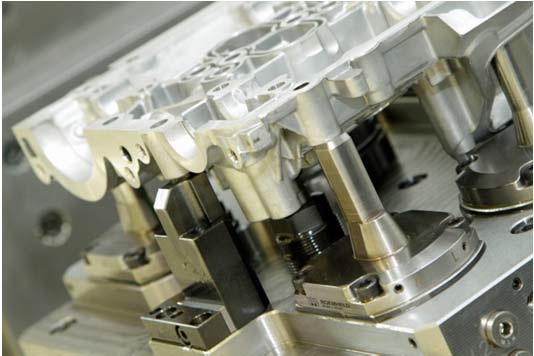
Automation and digital transformation are inspiring all sections of the METAV 2018: this applies particularly to the Moulding Area, which will be supporting die and mould making manufacturers in identifying the right machinery for their plants, and the VDMA’s Clamping Technology Forum. Römheld’s Managing Director Hans-Joachim Molka and Hainbuch’s Head of Product Management Stefan Nitsche reveal the innovations in clamping technology they intend to unveil in Düsseldorf for the T+M sector in February 2018.
In 2009, Römheld GmbH from Laubach still ranked among the newcomers in terms of clamping technology for the die and mould making sector since most people knew the company only from its workpiece clamping technology. Nowadays, it’s a widely acknowledged vendor for die and mould construction as well – for positioning cylinders, non-rotating cylinders or gate valves, for example. Hydraulic cylinders, for example, are used for actuating core pulls. To quote Managing Director Hans-Joachim Molka: “Hilma-Römheld GmbH also offers a comprehensive product range for clamping tools and moulds on presses, injection-moulding and die-casting machines.” In early 2017, moreover, this was followed by the foundation of a joint venture called Römheld Rivi GmbH (partner: Rivi Magnetics S.r.L., Sassuolo/Italy), who specialise in magnetic clamping technology for die and mould making inserts, which, says Hans-Joachim Molka “assures entirely new degrees of freedom and high flexibility.”
Embracing this technology shows that Römheld is opting for a variety of different drive types. “When it comes to fine-regulation or networking in Industry 4.0, electro-mechanical clamping systems have the advantage. When you need large forces in a minimised space, then hydraulics are definitely your best choice,” emphasises the Managing Director. “As the vendor with the world’s biggest portfolio of clamping technology, we aim to demonstrate our innovative vigour. Which is why we are continuing to design-enhance the drive types concerned, and will for the future be offering disparate drive types and technologies.”
Interactive real-time control for the manufacturing system
But the much-hyped issues of automation and digital transformation are also having an effect on clamping technology. For Hans-Joachim Molka, clamping technology is as an integral constituent of manufacturing systems more than just hardware pure and simple. “The clamping components supply data to the entire system, and thus contribute towards interactive real-time control of the manufacturing system concerned,” explains the expert. “In terms of technology, the sector can already deliver quite a lot. The exciting thing about Industry 4.0 will be the resultant business models.” Visitors will find out more at the Moulding Area and the VDMA’s Clamping Technology Forum, which will be chaired by its co-initiator Hans-Joachim Molka.
At the forum, Stefan Nitsche, Head of Product Management at Hainbuch GmbH in Marbach, will be describing how clamping technology can improve added value creation for digital manufacturing, and showing how make-ready and maintenance times can be reduced beforehand and replaced by productive, process-dependable machine runtimes.
This applies in particular to tool and mould manufacturers, who nowadays, says Stefan Nitsche, attach particularly high priority “to fast change-overs and minimised make-ready times using quick-change systems like Centrotex”. The customer doesn’t want to lose any time, and insists on starting his machining operations as swiftly as possible using the appropriate clamping device for his workpiece. “In parallel to this, we’re noticing very high demand for our mini-series,” says the Head of Product Management. “These chucks have 30 per cent less mass, a diameter reduced by a third, and they are compatible with the flexible modularised system.” For example, he continues, a user can change over from external to internal clamping in 30 seconds with an adaption clamping mandrel.
Self-regulating processes for no extra outlay
METAV 2018 in Düsseldorf, automatic, intelligent clamping is also expected to play an important role for tool and mould manufacturers. Hainbuch has been a significant player in this field for a decade now: in 2007, with the Toplus IQ chuck, the company ranked among the pioneers of intelligent clamping technology. Meanwhile, many users have already realised the benefits offered by measuring the clamping force, determining the soiling and maintenance status, and detecting the clamping diameter down to an accuracy of 0.01 mm. To quote Stefan Nitsche: ““This enables machining processes to be self-regulated for no extra outlay. A cost-intensive machine standstill entailing manual intervention is required only if the parameters have moved outside the specification.” To give an example: the clamping force may alter due to soiling or washing away of the clamping grease. The intelligent clamping device detects the change, and recommends the appropriate maintenance (e.g. cleaning the chuck). “ In the field of automation, says the expert, many automation firms, machinery manufacturers and end-users are already opting for “automated clamping-chuck and workpiece-stop change-overs”.















